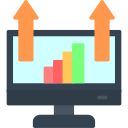Data-driven Techniques for Optimizing Marketing Campaigns
Harnessing the power of data has revolutionized the way modern marketers plan, execute, and refine their campaigns. Data-driven techniques allow brands to go beyond gut instinct, leveraging analytics, machine learning, and real-time feedback to reach the right audience, in the right way, at the right time. By systematically analyzing customer behaviors and campaign metrics, marketers can make informed decisions that drive higher engagement, increased conversions, and improved ROI. This page delves into the essential data-driven strategies every marketer needs to optimize their campaigns for maximum impact.

Setting Clear Objectives through Data Analysis
Aligning Business KPIs with Campaign Goals
Establishing a direct connection between broader business key performance indicators (KPIs) and your campaign goals is essential. Data analysis enables organizations to break down big-picture objectives—like revenue growth or customer retention—into specific marketing targets such as lead generation or website traffic. When marketers link their campaigns to high-level KPIs based on historical data trends, ongoing campaigns stay relevant, measurable, and impactful. This alignment ensures that every marketing effort contributes tangibly to the business’s bottom line, avoiding wasted resources and focusing on what truly matters.
Utilizing Historical Data to Set Benchmarks
Before launching a campaign, examining past performance data is critical. By reviewing analytics from previous campaigns, marketers can identify what worked and what didn’t. This historical context helps set realistic benchmarks, like open rates, click-through rates, or conversion percentages. These data-derived values inform campaign goals that are challenging yet achievable. Additionally, analyzing prior successes and shortcomings gives insight into seasonality, optimal timing, and the types of content most likely to drive engagement within the target audience.
Identifying Data Gaps and Opportunities
To set optimal objectives, marketers must also identify information gaps in their datasets. Data analysis often reveals missing points, such as untracked customer journeys or overlooked attribution channels. Understanding these gaps is an opportunity to improve data collection methods and integrate new touchpoints or technologies. Filling these gaps leads to a holistic view of the customer and can uncover unique opportunities for differentiation in campaign execution and measurement, ultimately driving better results and smarter decision-making in the future.
Audience Segmentation and Personalization
Behavioral Segmentation for Targeted Messaging
Behavioral segmentation groups individuals based on actions such as browsing habits, purchase history, email engagement, or product usage patterns. By leveraging this data, marketers can craft messages that resonate on a personal level, addressing specific pain points, interests, and needs. Personalized ads, tailored email content, and targeted social posts can all be deployed, leading to higher engagement rates and improved brand loyalty. This approach not only increases conversion potential but also ensures marketing resources are focused on prospects most likely to take action.
Demographic and Psychographic Profiling
Data on demographics (like age, gender, income) combined with psychographics (values, interests, lifestyles) provides a comprehensive understanding of your audience. Employing these profiles helps marketers match the right product or message to the right subgroup. This tailored approach maximizes relevance and can uncover niche markets or audience segments previously overlooked. When campaigns speak directly to the unique needs and preferences of defined groups, they foster stronger emotional connections, improved customer satisfaction, and increased brand advocacy.
Real-time Personalization Engines
Advanced data-driven marketing utilizes real-time personalization engines powered by artificial intelligence and machine learning. These systems analyze user data as it’s generated—such as real-time browsing actions or social media activity—to adjust offers, content, and creative elements instantly. Dynamic website content, individualized product recommendations, and adaptive email sequences ensure that each interaction with the brand feels timely and relevant. As a result, real-time personalization leads to greater user engagement, lower bounce rates, and improved sales figures, all while enhancing the overall customer experience.
First-touch and last-touch attribution models assign conversion credit to either the initial or final interaction a user has before completing a desired action. Data from these models offers a simplified perspective, making it easier to identify which channels are driving initial interest or closing sales. While limited in scope, these models can reveal the strengths of top-of-funnel awareness campaigns versus bottom-of-funnel conversion drivers, giving marketers basic insight into channel contribution and informing resource allocation.

Real-time Performance Tracking

Dynamic analytics dashboards serve as the operational nerve center for data-driven marketers. They pull in live data from multiple sources—including website analytics, advertising platforms, and social media engagement—visualizing key metrics in clear, actionable formats. These dashboards allow teams to monitor campaign health at a glance and identify emerging issues or opportunities. This real-time visibility ensures that everyone, from strategists to creatives, can react quickly and make data-informed decisions throughout the campaign lifecycle.
Predictive Analytics and Machine Learning
Predictive analytics models analyze historical data, current campaign metrics, and external variables to forecast likely future outcomes. These forecasts make it possible to estimate lead volume, conversion rates, and revenue generation in advance. Marketers can then set better targets, manage stakeholder expectations, and prepare backup strategies for various scenarios. As models are refined over time, their predictive accuracy grows, offering a competitive edge in both planning and execution.


A/B testing is the gold standard for validating creative hypotheses. Marketers use data to structure controlled experiments, carefully selecting variables and defining clear success metrics. Proper experimental design ensures results are statistically significant and actionable. By comparing alternative headlines, layouts, or visuals across targeted audience segments, marketers can identify the precise creative factors that drive engagement and conversion, leading to more effective and persuasive campaigns every time.

Each A/B test provides valuable data that can be fed into an ongoing cycle of improvement. Marketers analyze results, implement winning variations, and then design new experiments to tackle fresh challenges or opportunities. Continuous experimentation, powered by real-time analytics tools, creates a culture of learning and innovation. Over time, this process yields progressively higher performance, as each campaign builds on the data-driven lessons of the past.

As marketing technology evolves, so too do the possibilities for creative optimization. Multi-variant testing lets marketers analyze combinations of multiple variables simultaneously, uncovering interactions and synergies between creative elements. Dynamic content testing, meanwhile, uses data to automatically tailor creative assets to individual users based on segmentation or real-time behavior. These advanced techniques drive higher relevance, deeper personalization, and ultimately greater campaign impact.

Centralized Data Management Systems
Centralized data management lies at the heart of effective marketing analytics. Platforms such as data warehouses or customer data platforms unify disparate data streams—from CRM tools, web analytics, ad networks, and more—into a single source of truth. This consolidation reduces inconsistencies and enables marketers to gain holistic insights, streamlining reporting, attribution, and optimization efforts. Centralization also simplifies compliance with privacy regulations, as data governance becomes far easier to administer.

API-driven Data Integration
Modern marketing stacks rely heavily on APIs to connect various tools and technologies. API-driven integration ensures that campaign data flows freely between advertising platforms, automation tools, analytics dashboards, and email marketing systems. With seamless interoperability, marketers can automate reporting, trigger cross-platform workflows, and ensure that every touchpoint is tracked and measured. Data integration lays the groundwork for complex attribution models, personalization engines, and predictive analytics solutions.

Data Quality Assurance and Governance
Even the most sophisticated data-driven strategies rely on the quality and integrity of their underlying data. Establishing robust data governance practices—including validation routines, deduplication processes, and standardized taxonomy—ensures that decision-making is based on accurate, trustworthy information. Regular audits and monitoring protect against errors and maintain the high level of confidence required for effective marketing optimization. Focusing on data quality from the outset safeguards every downstream process and maximizes the strategic value of integrated data.
